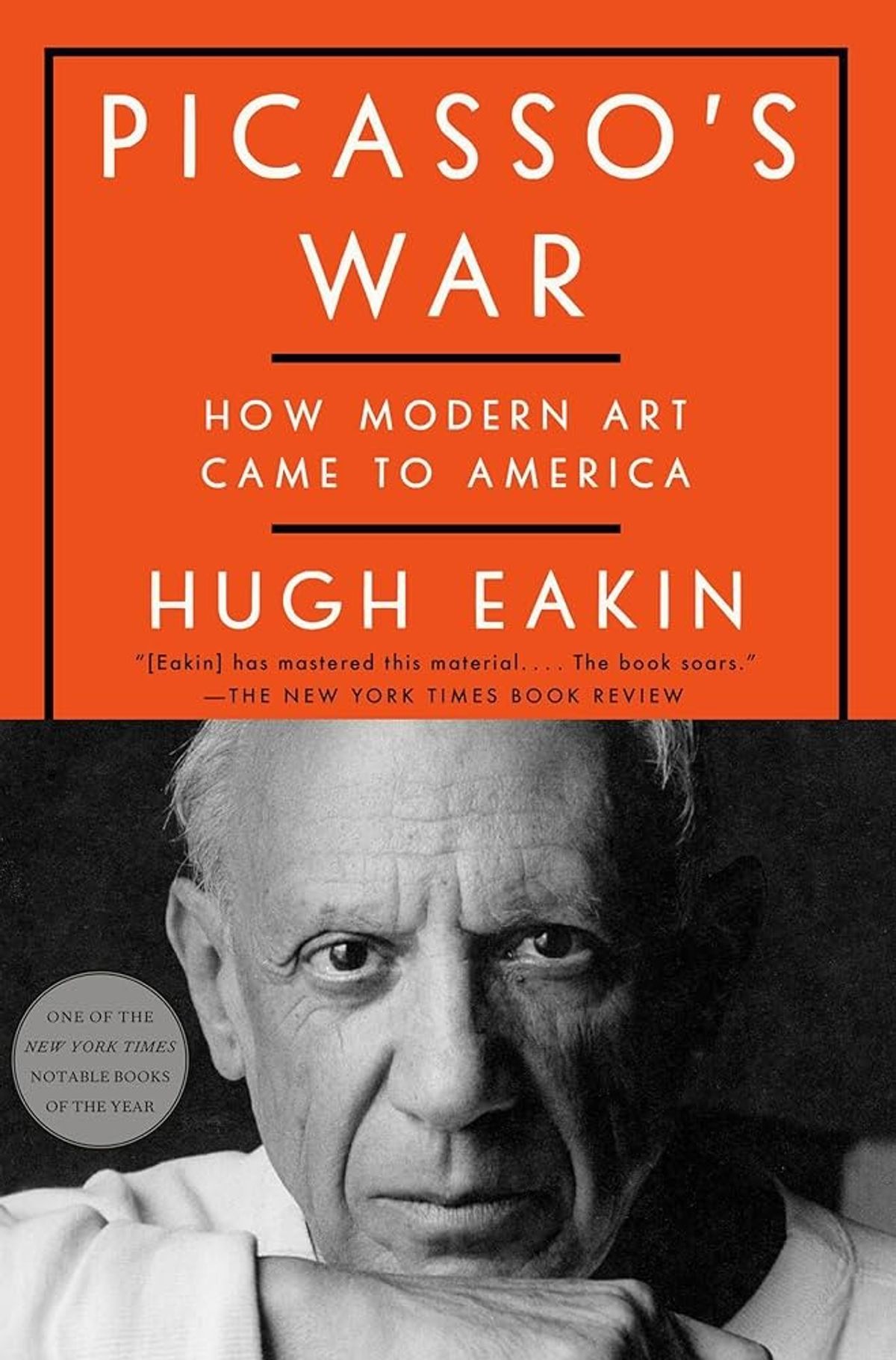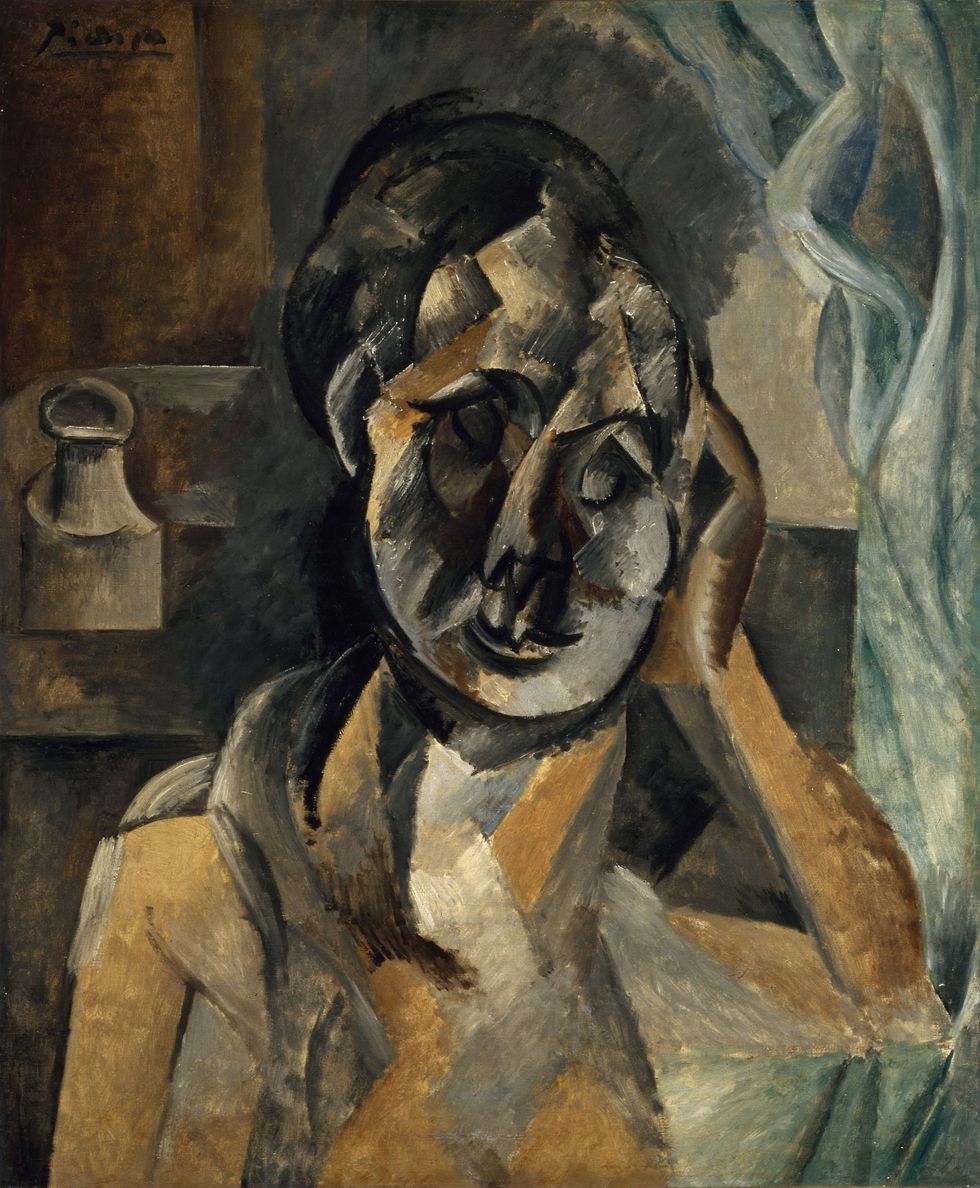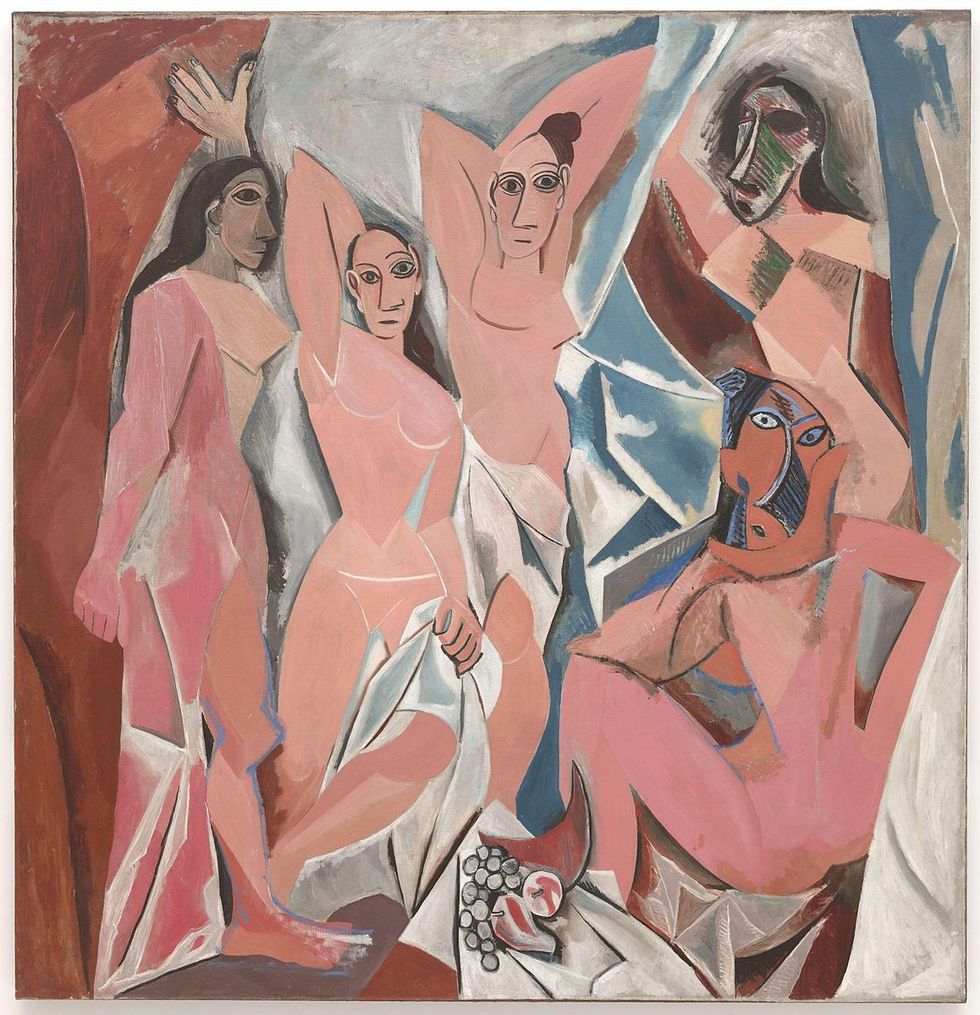Picasso’s American debut was a financial flop

Penguin Random House

‘Picasso’s War” by Foreign Affairs senior editor Hugh Eakin, who has written about the art world for publications like The New York Review of Books, Vanity Fair, The New Yorker and The New York Times, is not about Pablo Picasso’s time in Nazi-occupied Paris and being harassed by the Gestapo, nor about his 1937 oil painting “Guernica,” in response to the aerial bombing of civilians in the Basque town during the Spanish Civil War.
Instead, the Penguin Random House book’s subtitle makes a clearer statement of intent: “How Modern Art Came To America.” This war was not between military forces but a cultural war combating America’s distaste for the emerging modernism that had flourished in Europe in the early decades of the 20th century.
Eakin was present at The Norfolk Library Saturday, March 16, for a conversation with Robert Dance, author of the 2023 biography “Ferocious Ambition: Joan Crawford’s March to Stardom,” a member of the library’s board of directors and a trustee of the Wadsworth Atheneum Museum of Art in Hartford. The event was a “bonus” part of the Haystack Book Festival, a program presented by the Norfolk Foundation — delayed from the event’s 2023 October panel discussions due to scheduling.

Eakin and Dance’s conversation touched on the 1913 Armory Show in New York City. Also known as the International Exhibition of Modern Art, the Armory Show was a groundbreaking event and marked the inaugural showcase of modern art in the United States. It served as a pivotal platform, acquainting American audiences — for better or worse, per the conservative attitudes of the day — with prominent European avant-garde figures like Marcel Duchamp and Henri Matisse, catalyzing a profound shift in the landscape of American art.
“The one thing to keep in mind is that images circulate easily today, so we’re even familiar with art that we haven’t seen, but the opposite was true 100 years ago,” Eakin said at the Norfolk Library. “Everything had to be seen, you had to confront it, and there was a scarcity, especially of new art. Access to artworks was very limited unless you were traveling to Europe. The [American] taste at the time was: You have a country that is an insecure, powerful new country that’s just arrived on the world scene. What [America] wanted more than anything was to be regarded as a great European power. America wanted to have those Old Master paintings, paintings that were owned by princes and kings.”
This was also the shared opinion of such influential shapers of East Coast America’s established art world, like art collector and philanthropist Isabella Stewart Gardener, who went on to found Boston’s Isabella Stewart Gardner Museum in 1903; financier John Pierpont Morgan, one of the greatest benefactors of the Metropolitan Museum of Art; and art collector and industrialist Henry Clay Frick, whose collection of distinguished Old Master paintings can be seen today at The Frick Collection on the Upper East Side of New York City.

“The idea of new art having value was a shocking concept,” Eakin continued. “There was also a larger tradition of insecurity, but also theorizing about deviant art — what would come to be called ‘degenerate art.’ We think of this as a Nazi term, but actually, the conversation about degeneracy in art starts in the United States, and it starts very much with shows like the Armory Show.”
Picasso had actually shown work in America prior to the 1913 Armory Show. In 1911, Alfred Stieglitz, an American photographer and gallerist who would go on to marry modernist painter Georgia O’Keeffe, showcased the first exhibition of Picasso’s drawings in the United States in his gallery 291, located on Manhattan’s Fifth Avenue. Eakin noted that 83 cubist drawings by Picasso were shown, each priced at $12 dollars. Only one sold — to American artist and critic Hamilton Easter Field. The two had already met in Paris.
For a pop culture perspective of Picasso at the time, we can look to James Cameron’s 1997 blockbuster “Titanic,” where Kate Winslet’s American socialite character Rose has brought Picasso’s 1907 pro-cubist oil painting “Les Demoiselles d’Avignon” aboard the RMS Titanic. This is a bit of historical revisionism, as “Les Demoiselles d’Avignon” did not sink with the ship but is hanging in The Museum of Modern Art thanks to an acquisition by the museum’s patron, Lillie P. Bliss, who features prominently in the later half of Eakin’s book. Still, the remark by Rose’s fiancé, an American industrialist, rings true for the time and his own social circles: “Something Picasso… He won’t amount to a thing. Trust me, he won’t.”
Housatonic Valley Regional High School, where the price of school lunch will increase to $4.00 beginning Jan. 5.
FALLS VILLAGE -- School lunch prices will increase at select schools in Regional School District No. 1 beginning Jan. 5, 2026, following a deficit in the district’s food service account and rising food costs tied to federal meal compliance requirements.
District officials announced the changes in a letter to families dated Monday, Dec. 15, signed by Superintendent Melony Brady-Shanley and Business Manager Samuel J. Herrick
Under the new pricing, lunches at Lee H. Kellogg School and Cornwall Consolidated School will increase by 25 cents to $3.75, while lunches at Housatonic Valley Regional High School will rise by 50 cents to $4.00.
According to the district, the food service program depends on revenue from lunch sales as well as federal reimbursement. Increased food costs and compliance requirements contributed to the shortfall during the 2024–2025 fiscal year.
School lunch prices have remained unchanged since the 2019–2020 school year, prior to the COVID-19 pandemic. In the years that followed, the district used COVID-19 relief funds to allow students to receive lunches at no cost.
Families who believe they may qualify for free or reduced-price lunch may apply at any time during the school year. Applications are available online for Housatonic Valley Regional High School, Lee H. Kellogg School and Cornwall Consolidated School.
The lunch price increase applies only to these three District No. 1 schools, as Housatonic Valley Regional High School oversees the food service programs at Lee H. Kellogg School and Cornwall Consolidated School. Other schools in the district operate independent food service programs and are not affected.
Runners line up at the starting line alongside Santa before the start of the 5th Annual North Canaan Santa Chase 5K on Saturday, Dec. 13.
NORTH CANAAN — Forty-eight runners braved frigid temperatures to participate in the 5th Annual North Canaan Santa Chase 5K Road Race on Saturday, Dec. 13.
Michael Mills, 45, of Goshen, led the pack with a time of 19 minutes, 15-seconds, averaging a 6:12-per-mile pace. Mills won the race for the third time and said he stays in shape by running with his daughter, a freshman at Lakeview High School in Litchfield.

Don Green, 64, of Red Hook, New York, was second among male runners with a time of 21:17 and a 6:52-per-mile pace. Becky Wilkinson, 47, of Southfield, Massachusetts, was the first woman to cross the finish line with a time of 22:16, averaging a 7:11-per-mile pace. Wilkinson finished fourth overall.
Margaret Banker, 52, of Lakeville, finished second among women runners with a time of 23:59 and a 7:44-per-mile pace.
Runners came from all over Connecticut, Massachusetts and New York. One runner listed home as London, England. Many were members of the Run 169 Towns Society, a group that is dedicated to completing races in every one of Connecticut’s 169 towns. Elizabeth Smith, 32, of Manchester, a member of Run 169, said this was her 162nd town.
“I started 10 years ago,” Smith said. Her husband, Daniel, 33, has run races in 73 Connecticut towns, now including North Canaan. He was eager to know where to get a good cup of coffee after the race.
Santa, who got a head start on the group of runners but finished next to last with a time of 44:14, has been a feature in the North Canaan race since it started five years ago.
The 5K proceeds from a start in front of the North Canaan Elementary School on Pease Street to course around the Town Hall parking lot, up West Main Street past the transfer station to the state line and back. Cheryl Ambrosi, 45, of Danbury, was the last to cross the finish line with her dog Benji. “It was so much fun,” she said as she ended, even though she didn’t catch Santa.

The Torrington Transfer Station, where the Northwest Resource Recovery Authority plans to expand operations using a $350,000 state grant.
TORRINGTON — The Northwest Resource Recovery Authority, a public entity formed this year to preserve municipal control over trash and recycling services in northwest Connecticut, has been awarded $350,000 in grant funds to develop and expand its operations.
The funding comes from the Department of Energy and Environmental Protection via its Sustainable Materials Management grant program. It is intended to help the NRRA establish operations at the Torrington Transfer Station as well as support regional education, transportation, hauler registration and partnerships with other authorities.
Founded by the City of Torrington in May 2025, the NRRA was established to oversee regional municipal solid waste management. Its creation followed a $3.25 million offer by USA Waste & Recycling to purchase the Torrington Transfer Station — a sale that would have privatized trash services in the region.
The proposed sale was initially approved by the MIRA Dissolution Authority, the entity responsible for dissolving the state’s former Materials Innovation and Recycling Authority, which owned the Transfer Station at the time. Before the transaction could close, the state intervened and directed that the facility’s operating permit be assigned to the NRRA to preserve a publicly controlled alternative.
MIRA has since dissolved, and the Transfer Station is currently operated by the state Department of Administrative Services. Many towns in northwest Connecticut have expressed interest in joining the NRRA. As of December, Torrington and Goshen were the only two municipalities in the authority.
At the Dec. 11 meeting of the Northwest Hills Council of Governments (COG) — a regional planning body representing 21 municipalities in northwest Connecticut — Director of Community and Economic Development Rista Malanca encouraged more towns to sign on.
“We need towns to join the Northwest Resource Recovery Authority to show your support, show this is what you want to do,” Malanca said.
Salisbury First Selectman Curtis Rand said his municipality is planning a town meeting in January to vote on a resolution to join the NRRA. Cornwall’s Board of Selectmen recently discussed scheduling a town meeting in the winter for the same purpose. Sharon, Falls Village and North Canaan have also expressed continued interest in pursuing a public option.
Kent is the northernmost member of the Housatonic Resource Recovery Authority, a regional solid waste authority representing 14 municipalities stretching south to Ridgefield. COG towns expressed interest in joining HRRA in 2024, but they were denied and set out to develop the NRRA.
“We also have been having conversations with the Capital Region Council of Governments and the Naugatuck Valley Council of Governments to think about how we can use existing resources, maybe some of these grant funds, to bring in shared resources or shared staffing that will help with some of the recycling coordinating efforts,” Malanca said.
With grant funds secured, NRRA aims to grow to a point that it can take over operations at Torrington Transfer Station to serve as a regional hauling hub. What happens to the trash after that has yet to be determined. Currently, it is being shipped to a landfill out of state. The existing municipal refuse hauling contracts that were established with the state expire in 2027.
The Salisbury Winter Sports Association (SWSA) will host its annual Junior Jump Camp, a two-day introduction to ski jumping, on Saturday and Sunday, Dec. 27 and 28, from 9 a.m. to 2 p.m. at Satre Hill in Salisbury.
The camp is open to children ages 7 and up and focuses on teaching the basics of ski jumping, with an emphasis on safety, balance and control, using SWSA’s smallest hill. No prior experience is required.
The cost is $50 per child and includes instruction and lunch on both days. For more information or to register, visit www.skireg.com/swsa-camp or email info@jumpfest.org